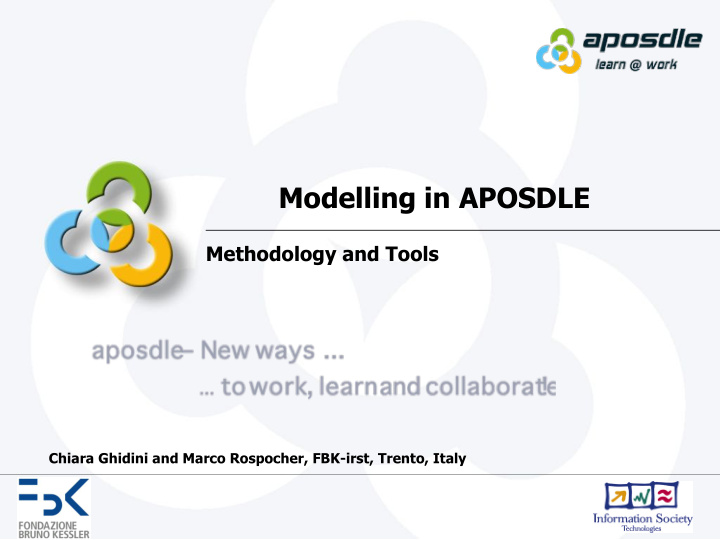



Modelling in APOSDLE Methodology and Tools Chiara Ghidini and Marco Rospocher, FBK-irst, Trento, Italy
Knowledge in APOSDLE 7 April 2018 / 2 n The APOSDLE approach to work-integrated learning is based on: a general purpose learning platfrom + n a knowledge base. n n The knowledge base formalises the environment in which users operate: their learning (business) domain; n the tasks (activities) they should perform; n their learning goals; n [See definition of Enterprise Model in Fox, M.S., Gruninger, M.: Enterprise modeling. AI Magazine 19(3) (1998) 109–121] ACTIVE Meeting, Innsbruck
The APOSDLE Knowledge Base 7 April 2018 / 3 User profile requires Learning goal Task model model of type Learning goal types is about Domain model Material uses Instructional types APOSDLE KB Snippets ACTIVE Meeting, Innsbruck
The problem of modelling 7 April 2018 / 4 n The core part of the KB is domain dependent but models are often not available in the enterprise; n Conflicting requirements: n Quality of models vs cost of modeling n Complex modeling team: n Several domain experts (domain/task/learning goals/…); n Knowledge engineers; n Different knowledge engineering skills; n GOAL: Devise a “methodology” and tools to support: n Cost effective development of good integrated models; n Effective collaboration between different actors; n Right granularity for APOSDLE; ACTIVE Meeting, Innsbruck
Our approach 7 April 2018 / 5 n A methodology to guide the applications partners in the construction of a good integrated model: domain and task modelling; 1. learning goal modelling. 2. n A new tool to support modelling based on two pillars: Semantic MediaWiki 1. à Collaborative (enterprise) modelling Tight integration between informal and formal modelling 2. à Informal/formal alignment of knowledge ACTIVE Meeting, Innsbruck
Collaborative modelling 7 April 2018 / 6 INFORMAL FORMAL ACTIVE Meeting, Innsbruck
Alignment of informal/formal knowledge 7 April 2018 / 7 ACTIVE Meeting, Innsbruck
The APOSDLE methodology 7 April 2018 / 8 Tools Steps Written guidelines 1. Scope & Boundaries and Resources Collection 2. Knowledge elicitation Knowledge elicitation a) Domain Experts techniques b) Digital Resources KnowMiner 3. Creation of Mo delling Wi Ki tool Requires knowledge of Alignmen t Automatic domain model task model Manual Guidelines 4. Domain and Task Model Validation Automatic Checks TACT tool 5. Modelling of learning goals Automatic checks 6. Validation of learning goal model ACTIVE Meeting, Innsbruck
MoKi: the Modelling wiKi 7 April 2018 / 9 n Built to support our approach: Collaborative modelling; n Informal/formal alignment of Knowledge. n n Built on top of Semantic MediaWiKi; n Why a (semantic) wiki? n wikis support collaborative editing; n users are quite familiar with wikis; n wikis do not require any software installation on the client side; n Semantic information provided in the wiki can be automatically extracted to create the formal models. ACTIVE Meeting, Innsbruck
Ideas behind MoKi 7 April 2018 / 10 n Facilitate an informal but structured description via templates; n Hides the complexity of formal modelling to domain experts; n Allow import/export of formal models; n Insert/reuse of already existing techniques for modelling (e.g., Know miner). n DEMO. ACTIVE Meeting, Innsbruck
TACT: the Task-Competence mapping Tool 7 April 2018 / 11 n Model learning goals as a bridge between tasks and topics (domain concepts); n Refines the “Knowledge required” relation between tasks and topics contained in MoKi with learning goal types; n Friendly user interface which hides how the learning goals are actually stored in the learning goal ontology. n Plans to insert TACT in MoKi to have a single interface/tool. ACTIVE Meeting, Innsbruck
TACT: Task-Competence mapping Tool 7 April 2018 / 12 n ADD screenshot ACTIVE Meeting, Innsbruck
Modelling in APOSDLE 7 April 2018 / 13 n Currently devising models for Third prototype: Information and Consulting on Industrial Property Rights n n Tasks: 13. Domain Concepts: 94. Learning Goals: 291 Information Technology Infrastructure Library (IT management topics) n n No Tasks. Domain Concepts: 100. Electromagnetism simulation domain n n Tasks: 47. Domain Concepts: 115. Learning Goals: 59 Innovation Management n n Tasks: 141. Domain Concepts: 133. Learning Goals: 248 RESCUE (requirement engineering methodology) n n Tasks: 77. Domain Concepts: 78. Learning Goals: 103 Statistical data analysis domain: n n Tasks: 19. Domain Concepts: 71. ACTIVE Meeting, Innsbruck
Things we are working on… 7 April 2018 / 14 Extend MoKi to: n Model ontology main elements; n Model workflow and process aspects (eg with graphical tools); n Better integrate informal/formal modelling; n Include validation steps; n Include TACT. ACTIVE Meeting, Innsbruck
Recommend
More recommend